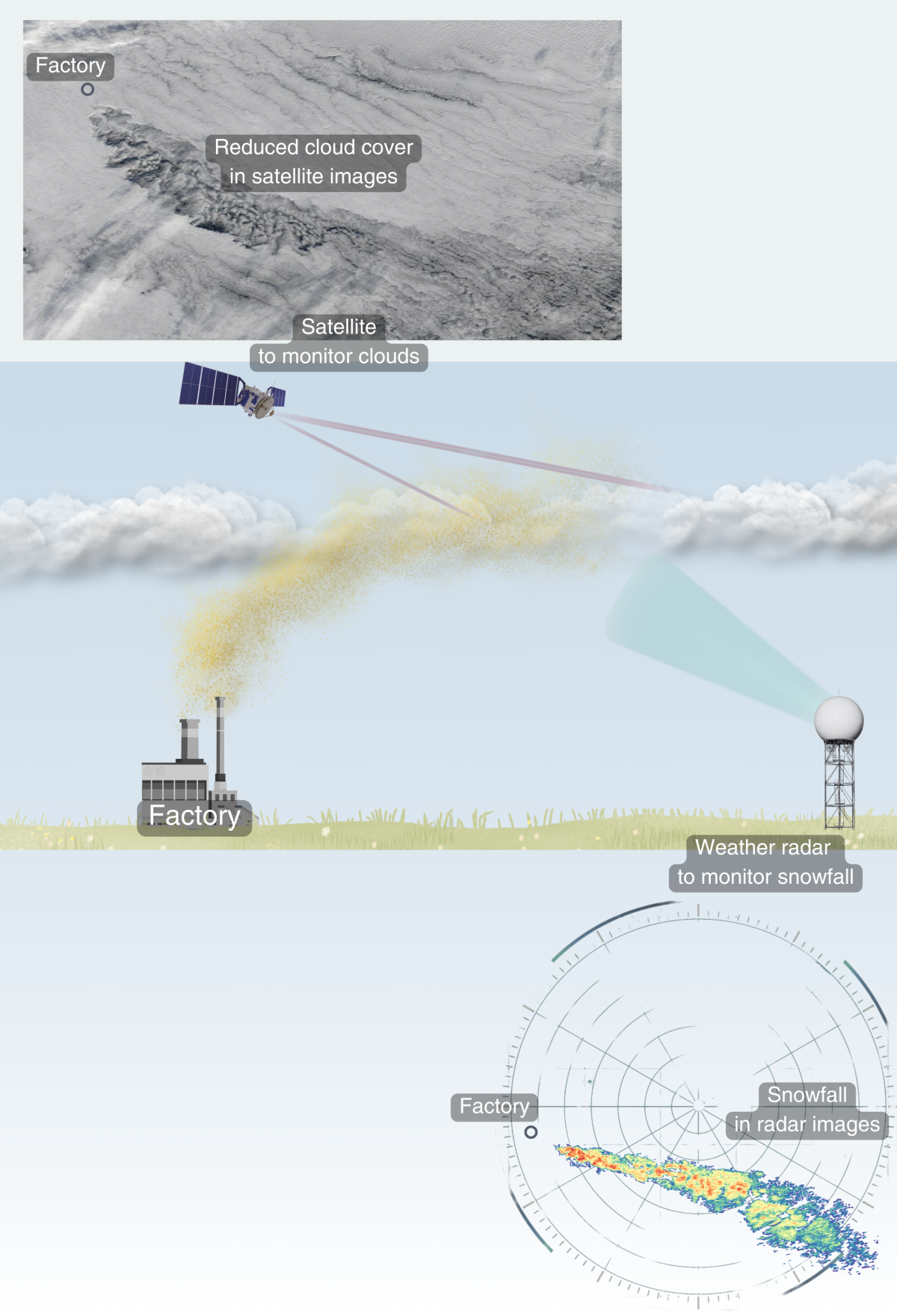Factory pollution is changing the weather—but not in the way you might think.
The tiny aerosol pollution particles poured out by industrial factories can trigger ice to form in the atmosphere, increasing snowfall nearby, according to a new paper in the journal Science.
We have long known that anthropogenic aerosols make clouds brighter by sparking the formation of more cloud droplets, but the new study reveals that the aerosol pollution may also trigger the droplets to freeze into ice at temperatures below 32 degrees Fahrenheit in a process known as glaciation.
“We discovered glaciation events where supercooled liquid-phase clouds are converted into ice clouds near anthropogenic aerosol hot spots such as metallurgical and cement industries, coal-fired power plants, and oil refineries, and, in five cases, downwind of nuclear power plants,” the researchers wrote in the paper.
Stock image of factory pollution (main) and snow falling (inset). Researchers have found that factory aerosol pollution may trigger snowfall.
ISTOCK / GETTY IMAGES PLUS
Factory air pollution consists of a range of pollutants that are by-products of industrial processes. The main pollutants typically include tiny particles (PM10 and PM2.5), sulfur dioxide, nitrogen oxides, carbon monoxide, volatile organic compounds, heavy metals, CO2 and methane.
In the paper, the researchers describe how they used satellite observations to analyze ice cloud presence near industrial hot spots across North America, Europe and Asia, combining this data with local snowfall levels.
When a cloud forms, water vapor condenses around tiny particles (cloud condensation nuclei) as liquid droplets if the temperature is above freezing. The droplets of water in clouds can stay liquid down to temperatures as low as -32.8 degrees Fahrenheit, which is called supercooling. Ice-nucleating particles (INPs) in the clouds—usually dust or pollen—allow water vapor to condense onto the small particles and freeze, falling as snow.

Observations of reduced cloud cover and snowfall downwind of industrial air pollution hotspots.
Velle Toll
The researchers suggest that the factory pollution particles can act as INPs, triggering ice formation and therefore increasing snowfall near factories.
The researchers found that there was ice formation—glaciation—in supercooled clouds downwind of 67 aerosol-emitting industrial sites.
“Compared with the nearby liquid-water clouds, shortwave reflectance was reduced by 14 percent and longwave radiance was increased by 4 percent in the glaciation-affected regions. There was an 8 percent reduction in cloud cover and an 18 percent reduction in cloud optical thickness. Additionally, daily glaciation-induced snowfall accumulations reached 15 millimeters,” the researchers wrote in the paper.
“Glaciation events downwind of industrial aerosol hot spots indicate that anthropogenic aerosols likely serve as ice-nucleating particles,” they said.
They did also find glaciation downwind of nuclear power plants, which do not release aerosols, indicating that factors other than aerosol emissions may influence ice formation.
“However, it is also possible that buoyant plumes from the nuclear power plants loft nearby aerosols that serve as INPs,” the researchers wrote. “Further research is needed to quantify the ability of anthropogenic aerosols to serve as INPs, quantify their impact on clouds, and clarify whether anthropogenic INPs influence Earth’s climate.”
Do you have a tip on a science story that Newsweek should be covering? Do you have a question about pollution? Let us know via [email protected].
References
Toll, V., Rahu, J., Keernik, H., Trofimov, H., Voormansik, T., Manshausen, P., Hung, E., Michelson, D., Christensen, M. W., Post, P., Junninen, H., Murray, B. J., Lohmann, U., Watson-Parris, D., Stier, P., Donaldson, N., Storelvmo, T., Kulmala, M., & Bellouin, N. (2024). Glaciation of liquid clouds, snowfall, and reduced cloud cover at industrial aerosol hot spots. Science, 386(6723). https://doi.org/10.1126/science.adl0303
This post was originally published on here






